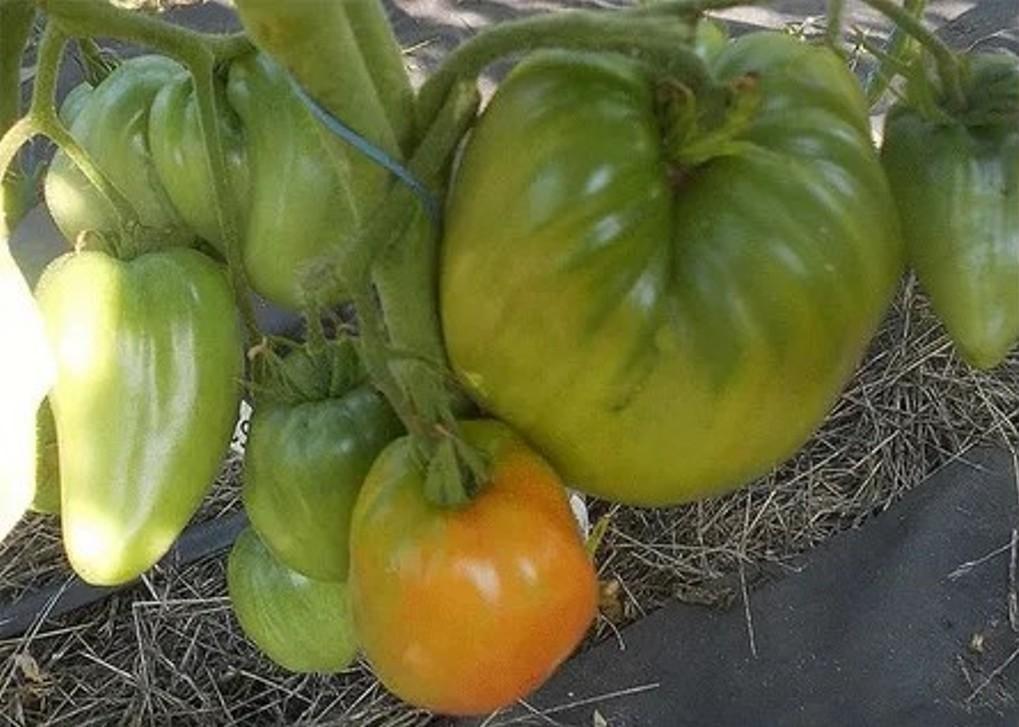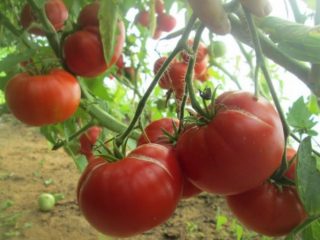Content
The pink scallop tomato is considered one of the best types in terms of taste. In the southern regions it can be grown in open ground; it is unpretentious and resistant to most diseases.
When and how did it appear
The tomato variety is included in the State Register of the Russian Federation and approved for use in 2021. The originator is LLC Breeding Firm GAVRISH, co-authors: Garish Sergey, Morev Victor, Amcheslavskaya Elena, Degovtsova Tatyana, Volok Olga.
The Latin name of the tomato variety is Solanum lycopersicum L. var. Lycopersicum.

In the register, the Pink Scallop tomato is listed under number 8058697
Description and characteristics of the tomato variety Scallop pink
Tomato variety Scallop pink belongs to the group of indeterminate plants. The bushes are tall, stretching up to 1.5-1.8 meters.
Tomatoes are large in size, heart-shaped, with barely visible ribs. Medium density, pink color. When unripe, they are light green in color, with a spot of a darker shade near the stalk.The maximum fruit weight is 200-250 grams, but with quality care you can get tomatoes weighing up to 400.
The taste of the tomato is excellent: the flesh is tender, sweetish, rich tomato, with a light aroma. Fruits with a small number of seeds, the pulp is sugary at the break.

Tomatoes are 95% water
Ripening time
The tomato is mid-season, from the first shoots to the harvest it takes from 105 to 110 days. Due to the long ripening period, tomatoes are harvested throughout almost the entire season.
Tomato yield Pink scallop
When growing tomatoes in a film greenhouse, you can harvest from 8.5 to 10 kg per 1 square meter. In open ground the yield is slightly lower.
Resistance to adverse factors
The tomato variety Scallop pink is resistant to most Solanaceae diseases. These include brown spot and fusarium wilt.
Where is it grown?
The Pink Scallops tomato variety is suitable for growing throughout the country. In regions with a warm climate, it can be planted under temporary film cover and in open ground. In other areas - in greenhouses.
According to the State Register, the crop is approved for use in the Far East, in Western, Eastern Siberia, in the Middle Volga, Lower Volga region, in the North Caucasus, in the Central Black Earth region, in the Volga-Vyatka and northern, western, central Siberia.
Methods of application
Pink scallop tomatoes are ideal for fresh consumption. Tomatoes can be canned and prepared into preparations ranging from tomato juice to ketchup. They are suitable for decoration and adding to any culinary dishes.
Advantages and disadvantages
Pink scallop is a sweet and tasty tomato, but these are not the only advantages of the variety.

Tomatoes contain several times more vitamin C than oranges.
Pros:
- large fruit;
- long fruiting period;
- seeds remain viable for 10 years;
- high productivity;
- fruits with few seeds.
Minuses:
- requires formation;
- Garter required.
Landing dates and rules
Tomato seeds are sown for seedlings in March. Picking is carried out at the stage of appearance of the first true leaf. The seedlings are transferred to the greenhouse in early May. A tomato requires mandatory formation into one or two stems. At an early stage, it is tied to a support. Excess shoots on a tomato bush are regularly removed.

It is better to calculate the time of sowing seeds depending on the growing region
If tomato seedlings are transferred to the ground at a later date, they will already be overgrown and, accordingly, will take longer to take root.
The following soil mixture is recommended for seeds:
- 1 part vermicompost;
- 4 parts peat;
- Fitosporin solution - one tablespoon per 1 liter of water.
After mixing the first two components, the resulting soil is treated with a fungicide solution. Instead of Fitosporin, you can use hydrogen peroxide or potassium permanganate for tomato seeds.
The seeds are immersed in the soil to a depth of 1 cm. It allows dense sowing, as young bushes tolerate picking well. The containers are covered with plastic film and the air temperature is maintained at least +24-25 °C.

After the first loops appear, the film cover is removed
After the formation of 2-3 strong leaves, the seedlings dive.10 days before planting in a permanent place, the seedlings are subjected to a hardening procedure. Planting in the ground is carried out approximately 60-65 days after sowing. The main thing is that the air temperature outside does not drop below +16 °C for several days. Planting pattern – 40x60 cm.
How to properly care
Standard rules for caring for Pink Scallop tomatoes:
- It is better to water in the evening, when the sun enters the passive phase;
- It takes about 1 liter of water per bush;
- You need to water the tomatoes at least twice a week, but always take into account the season and amount of rain;
- when watering, you need to try to prevent moisture from getting on the foliage, and the accumulated moisture does not cause burns and the appearance of fungus;
- remove weeds and loosen the soil as necessary, ideally the procedures are carried out 1-2 times a week;
- during the loosening process, care must be taken not to harm the roots;
- Fertilizing is applied only after watering.
Disease and pest control
Most tomato pests live in the soil. Therefore, the soil must be updated at least once every 3-4 years. It is important to observe crop rotation, that is, alternating planting of different crops in a separate area.
Perennial weeds pose a huge threat to garden crops, so regular weeding is necessary. It is important to maintain neutral acidity on an ongoing basis. Dolomite flour, chalk, and ash are suitable for this.
If tomatoes are grown in a greenhouse, it must also be processed after the last harvest.It can be washed with ordinary soapy water or Farmayod (100 ml of product per 10 liters of water). Viral and fungal spores should not be allowed to survive the winter. If this happens, then you should not count on a large harvest.
Before sowing seeds, the prepared soil must be subjected to a disinfection procedure. Copper sulfate, potassium permanganate or Previkur are suitable for this.
Conclusion
The Pink Scallop tomato produces tasty and large fruits. It is unpretentious in care, does not require special attention and resists most diseases of the Solanaceae family.
Reviews from gardeners about the pink scallop tomato









